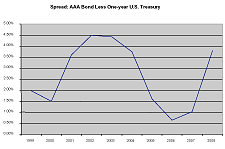Betting on the spreads has become a big business for the gambling industry. Read any newspaper and you can usually find a long list of point spreads in all of the major sports for all of your favorite teams. Spreads of a different sort also drive the annuity industry.
In these difficult economic times, the one bright spot for the insurance industry is the sales of fixed annuities. These sales are driven mainly by the current favorable interest-rate-spread environment. There are a number of interest-rate spreads that need to be analyzed when discussing annuities.
The most important spread is the difference between corporate bonds and U.S. Treasuries. Because almost all insurance companies invest their assets in corporate bonds, the net investment earned rate for a company—and hence the credited interest rate on annuities—is highly dependent on the corporate-bond rate. On the other hand, bank CDs more closely follow the U.S. Treasury rate. Therefore, in addition to the favorable tax treatment for annuities, fixed annuities compare favorably to bank CDs when the spread between corporate bonds and U.S. Treasuries widens.
The chart in Figure 1 shows the spread in the last 10 years between a Moody’s corporate AAA bond rate and the Treasury constant one-year maturity rate.

As you can see, the spread at the end of 2008 is much wider than the last three years and is very similar to the spread from 2001 to 2004.
The corporate-bond spread is not the entire difference between fixed-annuity-credited rates and CD rates. Insurance companies have what is often termed an interest-rate spread to cover expenses, benefit costs, and targeted profit margins. These spreads do not generally vary over time, but do vary from company to company, depending on the cost structure of the insurance company and the product design. Most of the time these interest-rate spreads are 100 to 200 basis points, which reduces some of the spread difference between fixed annuities and CDs.
If you refer back to Figure 1, you can see that removing 100 basis points from the corporate spread would suggest that CDs had credited rates similar to fixed annuities in 2005 through 2007. There are other factors that affect each of these spreads, e.g., steepness of the yield curve, but the corporate spread is an important indicator of the competitive position of fixed annuities.
From the point of view of the insurance company, one must also consider the rising default costs on corporate bonds. The higher costs remove some of the advantage of the higher corporate spreads.
The effect of corporate interest-rate spreads varies depending on the type of fixed annuity. The multi-year guarantee annuities will be more dependent on the steepness of the yield curve than a typical deferred annuity. Annuities with a new-money-credited interest rate will react much faster to the current interest-rate environment than a portfolio-credited interest-rate product. However, for all fixed annuities the corporate-bond spread is an important item.
Another spread worth noting is the difference in the annual return in the stock market to the fixed-annuity-credited rate. There is no need to remind anyone that the fixed-annuity interest rate has been much greater recently than variable-annuity growth rates. This has caused variable-annuity sales to decrease significantly, while fixed-annuity sales have enjoyed a recent increase in sales.
The changing interest-rate environment has also affected market-value-adjusted (MVA) annuities. Surrender charges on MVA annuities increase or decrease depending on the current interest-rate environment. Surrender charges are adjusted downward, effectively boosting cash values, when the policy interest-credited rate is greater than the current interest new money rate. Conversely, the surrender charges are adjusted upward when the policy interest-credited rate is less than the current new money rate. Insurance companies attach MVAs to fixed annuities to reduce disintermediation risk (the need to sell bonds at a loss to cover early withdrawal of cash value by the annuity holder) in times of rising interest rates.
Depending on the contractual definition of current new money rate, some companies are finding that annuity holders are taking advantage of this environment and withdrawing some or all of their cash value and placing the money in more competitive annuity products. This means that the spread between the policy interest-credited rate and the current interest new money rate is also important.
To the extent that historically wide bond spreads do not foretell severe levels of bond default activity, this could be a very favorable time to sell fixed annuities. Savvy companies will want to weigh this opportunity with a careful understanding of the risks involved under assorted economic scenarios. Planners will want to rethink client allocations in a way that may highlight an enhanced, beneficial role for fixed annuities.